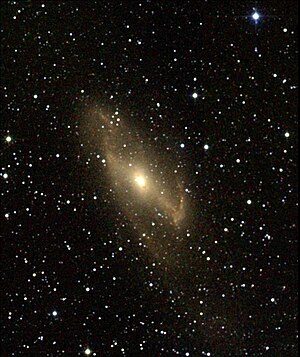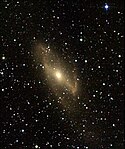Maffei 2
| Galaxie Maffei 2 | |
|---|---|
 | |
| AladinLite | |
| Sternbild | Kassiopeia |
| Position Äquinoktium: J2000.0, Epoche: J2000.0 | |
| Rektaszension | 02h 41m 55,1s[1] |
| Deklination | +59° 36′ 15″[1] |
| Erscheinungsbild | |
| Morphologischer Typ | SAB(rs)bc[1] |
| Helligkeit (visuell) | 16,0 mag[1] |
| Winkelausdehnung | 15,2′ × 7,0′[1] |
| Physikalische Daten | |
| Zugehörigkeit | Maffei-Gruppe |
| Rotverschiebung | −0,000057 ± 0,000017[1] |
| Radialgeschwindigkeit | (−17 ± 5) km/s[1] |
| Entfernung | 9.800.000 Lj / 3.000.000 pc [2] |
| Geschichte | |
| Entdeckung | Paolo Maffei |
| Entdeckungsdatum | 1967 |
| Katalogbezeichnungen | |
| UGCA 39 • PGC 10217 • IRAS 02381+5923 • 2MASX J02415509+5936147 • Sharpless 197 | |
Maffei 2 ist eine mittelgroße Spiralgalaxie im Sternbild der Kassiopeia etwa 10 Millionen Lichtjahre entfernt von unserem Sonnensystem.[2]
Maffei 2 und Maffei 1 wurden beide im Jahr 1967 vom italienischen Astronomen Paolo Maffei mittels ihrer Infrarotemissionen entdeckt. Maffei 2 liegt inmitten der Galaktischen Ebenen der Milchstraße der sogenannten Zone of Avoidance. 99,5 % des Lichts der Galaxie wird verdeckt oder absorbiert von Staubwolken und Sternen der Milchstraße,[3] weswegen sie im Optischen nur sehr schwer zu beobachten ist.
Kurz nach der Entdeckung von Maffei 2 wurde sie noch als Teil der Lokalen Gruppe angenommen. Neuere Messungen zeigen Maffei 2 ist Teil einer eigenen, der unserer Galaxiengruppe der Lokalen Gruppe am nächsten gelegenen Galaxiengruppe der Maffei-Gruppe.
Galerie
Die Herz- und Seelennebel. Darunter die hier leicht blaue Spiralgalaxie in der Mitte am unteren Rand des Bildes ist Maffei 2.
Maffei 2 ist die Spiralgalaxie oben links, Maffei 1 die blaue elliptische Galaxie im unteren rechten Eck.
Das Gesamtbild mit Maffei 2 und Maffei 1.
Siehe auch
Literatur
- König, Michael & Binnewies, Stefan (2019): Bildatlas der Galaxien: Die Astrophysik hinter den Astrofotografien, Stuttgart: Kosmos, S. 355
Weblinks
- SIMBAD: UGCA 39 -- Galaxy
- SEDS: Spiral Galaxy Maffei 2
- Maffei2
- Sky-Map.org
- Galaxies Beyond the Heart: Maffei 1 and 2 = Astronomy Picture of the Day 2010 March 9
Einzelnachweise
- ↑ a b c d e NASA/IPAC Extragalactic Database. In: Results for Maffei 2. Abgerufen am 24. Oktober 2011.
- ↑ a b I. D. Karachentsev: The Local Group and Other Neighboring Galaxy Groups. In: Astronomical Journal. 129. Jahrgang, Nr. 1, 2005, S. 178–188, doi:10.1086/426368, arxiv:astro-ph/0410065, bibcode:2005AJ....129..178K.
- ↑ The Hidden Galaxy. NASA, abgerufen am 7. April 2022.
Auf dieser Seite verwendete Medien
Maffei 1 & 2 galaxies as imaged by WISE
The Heart and Soul nebulae are seen in this infrared mosaic from NASA's Wide-field Infrared Survey Explorer, or WISE. Also visible near the bottom of this image are two galaxies, Maffei 1 and Maffei 2. Maffei 1 is the bluish elliptical object and Maffei 2 is the spiral galaxy. All four infra-red detectors aboard WISE were used to make this image. Colour is representational: blue and cyan represent infra-red light at wavelengths of 3.4 and 4.6 microns, which is dominated by light from stars. Green and red represent light at 12 and 22 microns, which is mostly light from warm dust.
A mosaic of images from WISE in the constellation of Cassiopeia. This region contains a large star forming nebula within the Milky Way Galaxy, called IC 1805 (sometimes called the Heart Nebula), a portion of which is seen at the right of the image. IC 1805 is over 6 thousand light-years from earth. Also visible in this image are two nearby galaxies, Maffei 1 and Maffei 2. In visible light these galaxies are hidden by [[:Category:|dust]] in IC 1805 and were unknown until 1968 when Paolo Maffei found them using infra-red observations. Both galaxies contain billions of stars and are located some 10 million light-years away (well outside our own Milky Way Galaxy). Maffei 1 is the bluish elliptical object in the centre of the image. It is a Lenticular type galaxy, which has a disk-like structure and a central bulge but no spiral structure or appreciable dust content. Maffei 2 (to the upper left of Maffei 1) is a Spiral type galaxy that also has a disk shape, but with a bar-like central bulge and two prominent dusty spiral arms.





